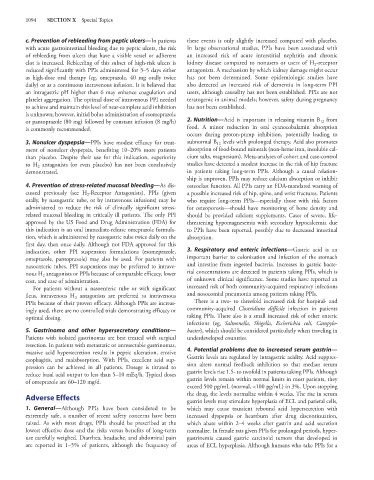Page 1108 - Basic _ Clinical Pharmacology ( PDFDrive )
P. 1108
1094 SECTION X Special Topics
c. Prevention of rebleeding from peptic ulcers—In patients these events is only slightly increased compared with placebo.
with acute gastrointestinal bleeding due to peptic ulcers, the risk In large observational studies, PPIs have been associated with
of rebleeding from ulcers that have a visible vessel or adherent an increased risk of acute interstitial nephritis and chronic
clot is increased. Rebleeding of this subset of high-risk ulcers is kidney disease compared to nonusers or users of H 2 -receptor
reduced significantly with PPIs administered for 3–5 days either antagonists. A mechanism by which kidney damage might occur
as high-dose oral therapy (eg, omeprazole, 40 mg orally twice has not been determined. Some epidemiologic studies have
daily) or as a continuous intravenous infusion. It is believed that also detected an increased risk of dementia in long-term PPI
an intragastric pH higher than 6 may enhance coagulation and users, although causality has not been established. PPIs are not
platelet aggregation. The optimal dose of intravenous PPI needed teratogenic in animal models; however, safety during pregnancy
to achieve and maintain this level of near-complete acid inhibition has not been established.
is unknown; however, initial bolus administration of esomeprazole
or pantoprazole (80 mg) followed by constant infusion (8 mg/h) 2. Nutrition—Acid is important in releasing vitamin B from
12
is commonly recommended. food. A minor reduction in oral cyanocobalamin absorption
occurs during proton-pump inhibition, potentially leading to
3. Nonulcer dyspepsia—PPIs have modest efficacy for treat- subnormal B levels with prolonged therapy. Acid also promotes
12
ment of nonulcer dyspepsia, benefiting 10–20% more patients absorption of food-bound minerals (non-heme iron, insoluble cal-
than placebo. Despite their use for this indication, superiority cium salts, magnesium). Meta-analyses of cohort and case-control
to H antagonists (or even placebo) has not been conclusively studies have detected a modest increase in the risk of hip fracture
2
demonstrated. in patients taking long-term PPIs. Although a causal relation-
ship is unproven, PPIs may reduce calcium absorption or inhibit
4. Prevention of stress-related mucosal bleeding—As dis- osteoclast function. All PPIs carry an FDA-mandated warning of
cussed previously (see H -Receptor Antagonists), PPIs (given a possible increased risk of hip, spine, and wrist fractures. Patients
2
orally, by nasogastric tube, or by intravenous infusions) may be who require long-term PPIs—especially those with risk factors
administered to reduce the risk of clinically significant stress- for osteoporosis—should have monitoring of bone density and
related mucosal bleeding in critically ill patients. The only PPI should be provided calcium supplements. Cases of severe, life-
approved by the US Food and Drug Administration (FDA) for threatening hypomagnesemia with secondary hypocalcemia due
this indication is an oral immediate-release omeprazole formula- to PPIs have been reported, possibly due to decreased intestinal
tion, which is administered by nasogastric tube twice daily on the absorption.
first day, then once daily. Although not FDA approved for this
indication, other PPI suspension formulations (esomeprazole, 3. Respiratory and enteric infections—Gastric acid is an
omeprazole, pantoprazole) may also be used. For patients with important barrier to colonization and infection of the stomach
nasoenteric tubes, PPI suspensions may be preferred to intrave- and intestine from ingested bacteria. Increases in gastric bacte-
nous H antagonists or PPIs because of comparable efficacy, lower rial concentrations are detected in patients taking PPIs, which is
2
cost, and ease of administration. of unknown clinical significance. Some studies have reported an
For patients without a nasoenteric tube or with significant increased risk of both community-acquired respiratory infections
ileus, intravenous H antagonists are preferred to intravenous and nosocomial pneumonia among patients taking PPIs.
2
PPIs because of their proven efficacy. Although PPIs are increas- There is a two- to threefold increased risk for hospital- and
ingly used, there are no controlled trials demonstrating efficacy or community-acquired Clostridium difficile infection in patients
optimal dosing. taking PPIs. There also is a small increased risk of other enteric
infections (eg, Salmonella, Shigella, Escherichia coli, Campylo-
5. Gastrinoma and other hypersecretory conditions— bacter), which should be considered particularly when traveling in
Patients with isolated gastrinomas are best treated with surgical underdeveloped countries.
resection. In patients with metastatic or unresectable gastrinomas,
massive acid hypersecretion results in peptic ulceration, erosive 4. Potential problems due to increased serum gastrin—
esophagitis, and malabsorption. With PPIs, excellent acid sup- Gastrin levels are regulated by intragastric acidity. Acid suppres-
pression can be achieved in all patients. Dosage is titrated to sion alters normal feedback inhibition so that median serum
reduce basal acid output to less than 5–10 mEq/h. Typical doses gastrin levels rise 1.5- to twofold in patients taking PPIs. Although
of omeprazole are 60–120 mg/d. gastrin levels remain within normal limits in most patients, they
exceed 500 pg/mL (normal, <100 pg/mL) in 3%. Upon stopping
Adverse Effects the drug, the levels normalize within 4 weeks. The rise in serum
gastrin levels may stimulate hyperplasia of ECL and parietal cells,
1. General—Although PPIs have been considered to be which may cause transient rebound acid hypersecretion with
extremely safe, a number of recent safety concerns have been increased dyspepsia or heartburn after drug discontinuation,
raised. As with most drugs, PPIs should be prescribed at the which abate within 2–4 weeks after gastrin and acid secretion
lowest effective dose and the risks versus benefits of long-term normalize. In female rats given PPIs for prolonged periods, hyper-
use carefully weighed. Diarrhea, headache, and abdominal pain gastrinemia caused gastric carcinoid tumors that developed in
are reported in 1–5% of patients, although the frequency of areas of ECL hyperplasia. Although humans who take PPIs for a

